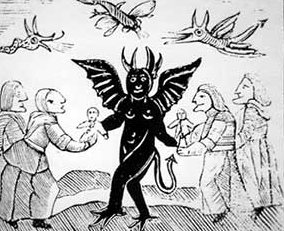|
The Hidden Symbolic Meaning of the Devil in Western Painting Satan Symbolism in Art History Byzantine, Gothic and Northern Renaissance artists represented Christian culture and values. Depictions of hell, Satan and hells mouth, rampaging demons reached a fever pitch after the great plague of the mid 14th century. Satan and his evil minions were often included as a sort of cautionary tale for illiterate church goers. According to theologist and author, Charles Bradlaugh "The writer of Revelation, adopting the view of some Hebrew writers, speaks of “the dragon, that old serpent which is the devil and Satan” and following this, it is urged that the Devil was the serpent of Genesis—that is, that it was really Satan who, in this guise, tempted Eve."
St. Augustine and the Devil c.1471 by Michael Pacher
Hildegard of Bingens, a medieval mystic and writer stated "The devil keeps man from good with a thousand machinations spewed from his belly, so that when a person sighs to do good, he pierces him with his shafts; and when he desires to embrace God with his whole heart in love, he subjects him to poisonous tribulations, seeking to pervert good work before God. And when a person seeks the viridity of virtue, the devil tells him that he does not know what he is doing, and he teaches him that he can set his own law for himself." Spiritually significant paintings created during the Gothic and Renaissance eras are complex, fraught with religious fervor and symbolism. William H. Hunt stated "When language was not transcendental enough to complete the meaning of a revelation, symbols were relied upon for heavenly teaching, and familiar images, chosen from the known, were made to mirror the unknown spiritual truth."
In a culture of limited literacy symbolic imagery was vital in enlightening the masses. Byzantine, Gothic and Early Renaissance paintings are rich in philosophical and Christian symbolism regarding serpents.
The Dragon - the emblem of heathen evil and Satan, the spiritual enemy of mankind. Saint Michael and Saint George are often depicted battling and slaying the dragon symbolizing their triumph over evil. Snake - symbolizes Satan; the presence of evil, fall of man The pitchfork and trident are both symbols of the devil Snake in a fruit tree - signifies the mans fall from grace as well as Satan's meddling in the affairs of men. A snake brazenly slithering across the middle of a thoroughfare or road - symbolizing the False Prophet leading the way to hell.
A devious serpent peeking out of a basket, urn or pot - a spiritual reminder of Satan's presence in unusual places.
The Color Red - a symbol of greediness and lust. Denotes sin; sins of mankind, Satan, original sin; temptation, Judas, Harrowing of Hell, The Fiery Furnace, Slaughter of the Innocents, the Apocalypse . Goat - symbol of the Devil. Satan is often depicted as a horned and hoofed goat-like creature. Wasp - symbol of the Devil or his henchmen. Satan is often depicted as a devilish winged creature. The wasp or yellow jacket is symbolic of Satan's relentless hunt for easily corrupted souls and backsliders. |
|
|
The Meaning of Sacred Symbols in Paintings. Most prominently featured symbols and their meaning: The Meaning of Sacred Symbols in Paintings. Most prominently featured symbols and their meaning:Clothing and Accessories The Four Evangelists Mythological Creatures © HistoryofPainters.com
If you feel you have worthwhile information you would like to
contribute we would love to hear from you. We collect essential
biographical information and artist quotes from folks all over the
globe and appreciate your participation. When submitting please, if
possible, site the source and provide English translation. Email to historyofpainter@gmail.com
|
|
Important Gothic Painters |


